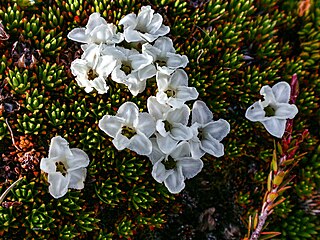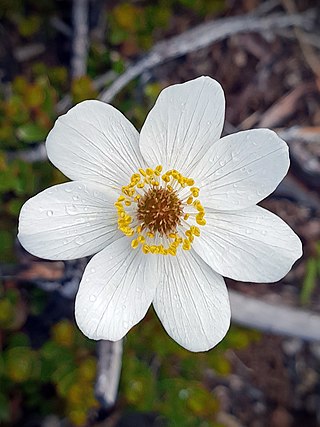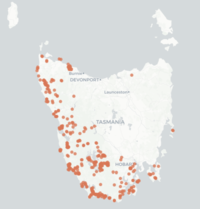
Southwest National Park is an Australian national park located in the south-west of Tasmania, bounded by the Franklin-Gordon Wild Rivers National Park to the north and the Hartz Mountains National Park to the east. It is a part of a chain of national parks and state reserves that make up the Tasmanian Wilderness World Heritage Area. Covering an area of 6,183 km2 (2,387 sq mi), it is Tasmania's largest national park.

Ambuchanania leucobryoides is the only species in the monotypic genus Ambuchanania. It is a Sphagnum-like moss endemic to Tasmania. Originally described as a species of Sphagnum, it is now a separate genus named after the original collector Alex M. Buchanan, (b.1944) an Australian botanist from the Tasmanian Herbarium in Hobart,. A. leucobryoides differs from the family Sphagnaceae in having elongate antheridia. It is entirely restricted to south-west Tasmania's Wilderness World Heritage Area where it occurs on white Precambrian quartzitic sand deposited by alluvial flows, and on margins of buttongrass sedge land. Species most commonly found in association with A. leucobryoides include: Leptocarpus tenax, Chordifex hookeri, and Actinotus suffocatus. Currently, A. leucobryoides is listed as rare under the Tasmanian Threatened Species Protection Act 1995.

Bromus madritensis is a species of brome grass known by the common name compact brome. The specific epithet madritensis refers to Madrid, Spain. It has a diploid number of 28.

Ewartia planchonii, commonly known as creeping cushionherb, is an endemic herb to alpine areas of Tasmania. E. planchonii is commonly found in the western highlands of Tasmania. The Ewartia genus is described as cushion plants/herbs due to the characteristic growth habits of low growing, highly compact mats which are made up of highly packed stems. These mats are slow-growing and are often located in soils that contain low nutrients.

Leucospermum cordifolium is an upright, evergreen shrub of up to 1½ m (5 ft) high from the Proteaceae. The flower heads are globe-shape with a flattened top, 10–12 cm (3.9–4.7 in) in diameter, and are carried individually or with two or three together mostly at a right angle to its branch. The perianth is 3–3½ cm long, yellow, orange or crimson in color. From each flower emerges a 4½–6 cm (1.8–2.4 in) long style sticking out horizontally but curving upwards near the obliquely, shell-shaped, thicker pollen presenter. This gives each head the appearance of a pincushion. Its common name is ornamental pincushion in English and bobbejaanklou in Afrikaans. It flowers between the middle of July and the end of November. It naturally occurs near the south coast of the Western Cape province of South Africa. Varieties and hybrids of this species are used as cut flower and garden plant.

Empodisma minus, commonly known as (lesser) wire rush or spreading rope-rush, is a perennial evergreen belonging to the southern-hemisphere family of monocotyledons called the Restionaceae. The Latin name Empodisma minus translates to “tangle-foot” “small”. E. minus is found from Queensland to South Australia, Tasmania and throughout New Zealand south of 38 ° latitude, or the central north island. Its current conservation status is “Least concerned”. In 2012 the new species Empodisma robustum was described in New Zealand, with what was previously described as E. minus from the lowland raised bogs of Waikato and Northland now being re-classified as E. robustum. E. minus remains an important peatformer in the south of New Zealand and in high altitude peatlands.

Gymnoschoenus sphaerocephalus, commonly known as buttongrass, is a species of tussock-forming sedge from southeastern Australia. It forms part of a unique habitat in Tasmania.

Gahnia grandis is a tussock-forming perennial plant found in southeastern mainland Australia and Tasmania.

Persoonia gunnii is a species of flowering plant in the family Proteaceae and is endemic to Tasmania. It is an erect shrub with young branchlets that are hairy at first, spatula-shaped to egg-shaped leaves with the narrower end towards the base, and white to cream-coloured flowers.

Orites revolutus , also known as narrow-leaf orites, is a Tasmanian endemic plant species in the family Proteaceae. Scottish botanist Robert Brown formally described the species in Transactions of the Linnean Society of London in 1810 from a specimen collected at Lake St Clair. Abundant in alpine and subalpine heath, it is a small to medium shrub 0.5 to 1.5 m tall, with relatively small, blunt leaves with strongly revolute margins. The white flowers grow on terminal spikes during summer. Being proteaceaous, O. revolutus is likely to provide a substantial food source for nectivorous animal species within its range.
Tasmania can be broadly divided into two distinct regions, eastern and western, that exhibit major differences in climate, geology and vegetation. This divide, termed Tyler’s Corridor, runs from just south of the northwestern corner, and continues south, cutting roughly down the center of the island. The vegetation changes occur principally due to variations in soil types, which are a result of the geological composition, and the vast difference in climate across the state. Generally, the west has a higher mean rainfall but poor acidic soil while the east has a lower mean rainfall but slightly more fertile soil. This results in a larger proportion of rainforest, moorland and wet sclerophyll vegetation dominating in the west and predominantly dry sclerophyll in the east.

Astelia alpina called pineapple grass, silver astelia, or perching lily is a commonly found species in alpine and subalpine areas of Tasmania and the Australian Alps. It is a perennial herb that typically dominates its environment by growing in dense clusters, called mats, in alpine bogs. There are two subspecies: Astelia alpina var. novae hollandiae from New South Wales and Victoria and Astelia alpina var. alpina endemic to Tasmania. Both subspecies appear very similar to each other. The species was originally described by Robert Brown.

Grevillea pilulifera, commonly known as woolly-flowered grevillea, is a species of flowering plant in the family Proteaceae and is endemic to the south-west of Western Australia. It is an erect or spreading shrub with linear to narrowly oblong leaves and hairy, white to cream-coloured flowers, the style with a bright yellow, later red tip.

Xyris marginata, commonly known as alpine yellow eye, is a monocot in the family Xyridaceae which is endemic to King Island (Tasmania) and Tasmania, commonly growing in button grass moorlands, at altitudes of up to 1070 meters (3,510.5 ft) above sea level. It was first collected by German-Australian botanist Ferdinand von Mueller in 1875.

Helichrysum pumilum, commonly known as dwarf everlasting, is a rosette herb from the family Asteraceae. It is endemic to Tasmania, where it is commonly found in the West and Southwest of the island state. It is distinctive by its inflorescence, with the flower stalk being densely matted in fine white hairs and the daisy-like flower head having numerous pink or white ray floret-like bracts.

Carpha alpina, commonly known as small flower-rush, is a tufted perennial sedge from the family Cyperaceae. It is found primarily in south-east Australia and both islands of New Zealand, but also in Papua New Guinea.

Olearia ledifolia, commonly known as rock daisy bush, is a species of flowering plant of the family Asteraceae. It is endemic to Tasmania and found at higher altitudes where it grows as a low, compact bush with tough, leathery leaves and small white and yellow daisy-like "flowers" in summer.

Dracophyllum minimum, commonly known as heath cushionplant or claspleaf heath, is a species of bolster cushion plant endemic to Tasmania, Australia. It is a low growing, highly compacted plant with white flowers, commonly found in alpine areas of the south, centre and west of Tasmania.

Anemone crassifolia, commonly known as mountain anemone, is a perennial herb in the family Ranunculaceae and is endemic to Tasmania, Australia. The species is common in high alpine moorlands of western and southern Tasmania at approximately 1000m. It is the only representative of the genus Anemone found in Australia.
Olearia hookeri, commonly known as crimsontip daisybush, is a species of flowering plant in the family Asteraceae and is endemic to Tasmania. It is a sticky shrub with small, narrowly linear leaves and white to bluish-purple and yellow, daisy-like inflorescences.




















